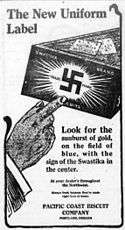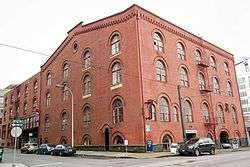Pacific Coast Biscuit Company
|
The Pacific Coast Biscuit Company Building in Portland, Oregon | |
Formerly called | Portland Biscuit Company |
|---|---|
| Public | |
| Industry | Snack foods |
| Fate | Purchased by Nabisco in 1930 |
| Headquarters | Portland, Oregon |
Key people | Charles M. Warner, John C. Hanrahan, William M. Laws, Herman Wittenberg, Moritz Thomsen, Charles Hotchkiss, A.M. Brookes |
| Products | Biscuits and Crackers |
| Brands | Abetta Biscuit, Abetta Oatmeal Crackers, Parfait Sugar Wafers, Fiesta Sugar Wafers, Elite Tea Biscuit, Toke Point Oysterettes, Fig Sultana, Marshmallo Dainties, Hoo Hoo Gingersnaps, Maritani Fruit Biscuit, Cocoanut Dainties, Old Fashioned Sugar Cookies, Zwieback, Fancy Assorted Cakes, Cheese Sandwich, Animal Box Crackers |
The Pacific Coast Biscuit Company was a conglomerate of baking companies headquartered in Portland, Oregon, United States. The company, also known as Pacific Coast, was formed in 1899, and it was purchased by the National Biscuit Company in 1930. It was the only baking company in the United States to trademark a swastika.
History
In the late 19th century, regional baking companies combined to form larger conglomerates, often known as Cracker Trusts. Of these, the largest was the National Biscuit Company that included 114 baking companies. It was incorporated in New Jersey in February 1898, and the company was later renamed Nabisco.[1] Prior to modern securities law, it was not uncommon for companies to inflate the value of their assets. Nabisco, for example, was capitalized at $55,000,000, but its estimated value in real assets was less than $25,000,000. Writing in Moody's Magazine, John Moody referred to the $30,000,000 discrepancy as "water."[2] The Pacific Coast Biscuit Company was formed to compete against Nabisco. It was incorporated in New Jersey in May 1899, and included seven companies that together controlled most of the commercial biscuit and cracker business west of the Rocky Mountains. The companies, also known as the Cracker Trust, were
- Portland Cracker Co. of Portland
- Oregon Cracker Co. of Portland
- Seattle Cracker and Candy Co. of Seattle
- Washington Cracker Co. of Spokane
- American Biscuit Co. of San Francisco
- Standard Biscuit Co. of San Francisco
- Southern California Cracker Co. of Los Angeles[3]
Although the combined assets of the seven companies were valued at less than $1,000,000, capitalization was $4,000,000, and the United States Investor described the trust as "a stock jobbing scheme, whereby the operators hope to make a lot of money out of the investing public."[4]
Three of the subsidiaries, the Washington Cracker Company, the Oregon Cracker Company, and the Portland Cracker Company were owned by Herman Wittenberg, an entrepreneur specializing in biscuit and cracker company management. Wittenberg started the Portland Cracker Company in 1886, and in the years thereafter he purchased several competing firms in Oregon and Washington. When Pacific Coast was organized, Wittenberg became vice president, and he remained in that office until the time of his death in 1912.[5]
Swastika trade mark

In 1907 Pacific Coast began using a red swastika trademark in its marketing. The swastika symbolized perfection and wholesomeness at the company and became a logo on many products. Packaging was designed to mimic that of Nabisco, and Pacific Coast's swastika was similar in color and placement to Nabisco's in-er-seal trademark, although it did not resemble the shape of Nabisco's trademark.[6]
The company marketed its products partly through newspaper advertising, and the ads gradually included a populist doctrine.[7] In the early 20th century, swastika references in Pacific states were not unknown, and they were meant to convey a sense of goodness. For example, in 1914 the first cinema in Sausalito, California, opened under the name "Swastika Theatre."[8]
Nabisco lawsuit
In 1914 Nabisco sued Pacific Coast in federal court for unfair competition and trademark infringement. The court found that Pacific Coast had engaged in unfair practices and issued an injunction barring the company from marketing several brands that were packaged similar to those of Nabisco, and the court ordered Pacific Coast to stop using its red swastika trademark. As a result of the court decision, Pacific Coast altered its packaging and redesigned its swastika.[6]
In 1930 Nabisco purchased Pacific Coast Biscuit Company and continued to operate its brands, and the swastika was replaced by Nabisco's in-er-seal logo.
See also
References
- ↑ "A Cake Combine: Biscuit and Cracker Companies Under One Management". Los Angeles Herald. William A. spalding. February 4, 1898. p. 1. Retrieved February 9, 2015.
- ↑ Moody, John (April 1907). "Growth of the National Biscuit Company". Moody's Magazine. New York: John Moody. III (5): 592. Retrieved February 9, 2015.
- ↑ "Pacific Coast Cracker and Candy Trust: Ninety-five per Cent of the Business West of the Rocky Mountains Controlled". The Daily Morning Astorian. Astoria: John T. Lighter. May 11, 1899. p. 1. Retrieved February 9, 2015.
- ↑ "Pacific Coast Cracker Trust: Some Facts Regarding a Much Overcapitalized Combine". United States Investor. Boston: Frank P. Bennett. 10 (21): 691. May 27, 1899. Retrieved February 9, 2015.
- ↑ Lockley, Fred (1928). History of the Columbia River Valley from the Dalles to the Sea. III. Chicago: S.J. Clarke. pp. 973–975.
- 1 2 Tomlinson, R.E. (1915). National Biscuit Company Trade Mark Litigation (Fifth ed.). U.S. Courts. pp. 173 – 228.
- ↑ The message in the ads evolved over time, especially after the death of Herman Wittenberg, to reflect principles of nationalism and militarism, although marketing at Pacific Coast preceded Nazi Germany by several years, and the Pacific Coast swastika was in use many years prior to the Nazi swastika.
- ↑ Berdahl, Doris (Fall 2012). "Show House to Shakespeare 1914 – 1960s". Moments in Time. Sausalito Historical Society. Archived from the original (PDF) on February 11, 2015. Retrieved February 11, 2015.
Further reading
- Coombs and Batchelor, We Are What We Sell: How Advertising Shapes American Life (ABC-CLIO, 2014)
- Swett, Selling under the Swastika: Advertising and Commercial Culture in Nazi Germany (Stanford University Press, 2013) How aspirations and anxieties are reflected in German advertising in the second, third, and fourth decades of the 20th century.
External links
| Wikimedia Commons has media related to Pacific Coast Biscuit Company Advertising. |
- Pacific Coast Biscuit Company Photographic Collection circa 1900-1929
- Guide to the National Biscuit Company photograph album, 1900-1935
- The Washington Cracker Company
- Obituary of Herman Wittenberg in The Oregonian
